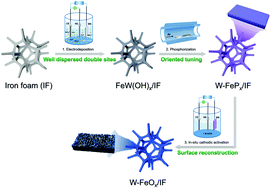Modulation engineering of in situ cathodic activation of FePx based on W-incorporation for the hydrogen evolution reaction†
Abstract
In situ electrochemical activation as a new pretreating method to adjust electrocatalytic performance attracts extensive attention. However, the activation mechanisms of electrocatalysts are still ambiguous. Herein, we propose a facile modulation strategy of in situ cathodic activation of FePx based on W-incorporation (W-FePx/IF) for the hydrogen evolution reaction (HER). The activated W-FeOx with obvious surface reconstruction demonstrates the role of W-incorporation for driving the cathodic activation of FePx, which suggests the larger surface area and more active sites. In fact, W incorporation can not only accelerate the cathodic activation process but also act as the adsorption sites for Had to form the synergistic effect with FeOx for water dissociation. The obtained W-FeOx/IF exhibits greatly enhanced HER activity featuring decreased overpotential from 237.7 to 154.0 mV at 100 mA cm−2, which may be ascribed to W-FeOx with double catalytic active sites after cathodic activation. Additionally, the modulation effects of cathodic activation can be exactly achieved by changing electrochemical parameters such as CV cycles. W-FeOx/IF also shows excellent long-term stability for at least 100 h at 100 mA cm−2. This modulation engineering based on metal doping is expected to provide inspiration for the understanding of the cathodic activation process for efficient electrocatalysts.



 Please wait while we load your content...
Please wait while we load your content...